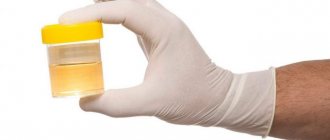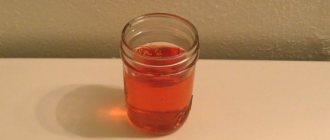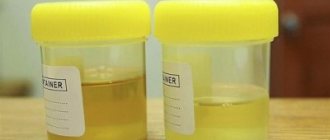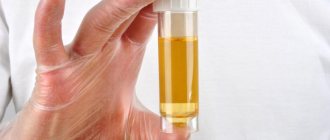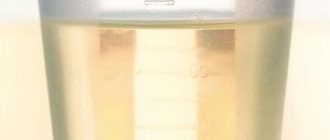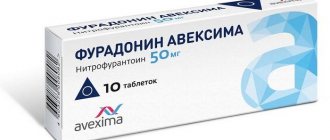What color is considered normal?
The coloring of urine is affected by the foods the child eats, medications taken, and what the mother eats.
Each age has its own urine color. At first, the newborn's urine is clear. Starting from the 2nd week of life, newborns become brick-colored. This is explained by the fact that from the 7th day the children's genitourinary system actively develops. This transformation with the baby’s urine does not last long. Over time, the normal indicator is yellowish (straw) urine. However, if the baby or mother (applies to breastfeeding) ate beets, the masses will darken to a pale purple color, and when she eats a lot of carrots, to light orange. When these foods are limited, the urine turns yellow again. These facts are not aberrations. The following colors of baby urine are considered abnormal:
- saturated: yellow, orange;
- dark: brown, green;
- bright: pink, red;
- pale: transparent, white.
Return to contents
Basic parameters of the norm
A healthy baby produces urine that is light yellow in color and without any odor. Urine begins to smell as you age. Normally the odor is faint. A sharp, distinct smell of urine indicates increased acetone, diabetes mellitus, or the presence of bacterial flora in the bladder.
Normally, urine foams, but quickly returns to its normal state. Light, pink, yellow urine in a newborn should in any case be transparent. Turbidity can only appear if the biomaterial is stored for a long time. A newborn's urine without impurities is normal.
What can you tell by the color of a baby’s urine?
If the color is yellow
The standard shade of baby urine is yellow, closer to light straw. Other colors of children's urine should alert parents. Dark yellow urine is caused by increased accumulation of bile pigment in the child’s body. Saturated yellow urine appears in a baby due to dehydration due to intestinal infections or a stomach disorder, as well as an infectious liver disease. When such urine appears in children, you should immediately seek help, because in some cases there is a threat to life.
Is dark urine a cause for concern?
It happens that in children the color of urine changes from light to dark. This happens because the bilirubin level in the excreted masses increases. Such manifestations indicate an increased concentration of bile pigment. The baby may have neonatal jaundice. Brown-red discoloration of urine indicates kidney problems. Therefore, if a child produces such urine when urinating, consult a doctor and remain under his supervision until recovery.
Orange urine
A change in a child's urine should raise alarm bells for parents. If bright yellow, pink or dark urine appears, children are experiencing inflammation or infection. This is a direct threat to the child's life.
If orange urine appears, this indicates excessive salt content in the child’s body or dehydration. With hyperthermia, stool upset and vomiting, children also produce saturated urine. This coloration is bad and requires immediate treatment from a pediatrician. But sometimes such a transformation in the color of children’s urine is the norm. After all, the color of a baby’s urine changes depending on the food. The urine discharge also becomes orange if the baby ate carrots the day before. The same rule applies to the mother if the child is breastfed. This change in shade is not dangerous for the health of babies.
What if it's transparent?
Colorless urine is typical for young children. Also, if the baby is older and is breastfed, clear urine indicates that the mother is eating a lot of foods that are high in water content. Clear urine occurs in patients who have diabetes mellitus, diabetes insipidus, renal failure, or who have used diuretics.
What other staining can be seen?
If the shade of urine in children turns green, this indicates obstructive jaundice. Babies under one month of age can also have pink urine. As soon as the baby is born, uric acid crystals come out when he urinates. Such dust-like spots are common in newborns. They should not be considered deviations, since the crystals are not dangerous to the baby’s life. If a child’s urine is bright, closer to a red hue, then the baby may produce a large number of red blood cells: a heart attack, kidney injury.
Bright yellow urine in a 2 year old child
The color of urine is one of the first parameters that is assessed during laboratory testing of this biological fluid. Particular attention should be paid to assessing the shade of the child’s urine - the baby may not feel any discomfort, but parents, upon seeing color changes, should immediately consult a doctor. Early diagnosis is the key to successful treatment.
Norm
When healthy, children's urine is straw-yellow in color, just like an adult's. This shade is obtained due to the presence of a pigment substance in urine - urobilin.
Urobilin is the end product of bilirubin metabolism.
In the digestive tract, bilirubin is converted into urobilinogen, which is subsequently transformed in the bloodstream into urobilin, which is excreted from the body by the kidneys.
Causes
In some cases, your baby's urine may appear bright yellow. This can be triggered by both physiological reasons and pathological provocateurs.
Physiological
Can dietary habits affect this? Yes, lemon-colored urine may appear when your child eats certain foods. They can be colored using artificial dyes. For example, candies, carbonated drinks, marmalade, so loved by children.
But urine can also acquire a bright color due to fruits and vegetables - citrus fruits, carrots, pumpkin and others. Natural pigment substances give biological fluid an intense yellow tint.
If the doctor sees a note in the laboratory report about the bright yellow color of the urine, then the first thing he will do is ask the parents what the child ate the day before.
Pathological
- Intoxication, acute intestinal infections, which are characterized by vomiting, diarrhea, profuse sweating.
- Pathologies that provoke the appearance of edema.
- Viral diseases accompanied by intense sweating.
- Taking diuretics and laxatives. You should not give such drugs to your child without medical advice. Changes in urine color are perhaps the most harmless of the complications of self-medication.
- Infectious pathologies of the liver.
- Biliary tract dysfunction.
- High concentration of oxalates in urine.
- Inflammatory pathologies of the genitourinary system.
- Congestion in the kidneys.
- Diseases in which the breakdown of hemoglobin is increased. When this substance breaks down, bilirubin is formed, which is subsequently transformed into urobilin, which in excess concentration gives the urine a bright yellow color.
Pathological causes of shade modification also include insufficient fluid intake and excessive physical activity coupled with a small amount of drinking.
Taking certain medications and vitamins.
If not enough water enters the child's body, it is intensively reabsorbed in the kidney tissue. Because of this, the urine concentrates and acquires a bright yellow tint. Therefore, it is important to ensure that the child consumes a sufficient amount of liquid, not only in the form of tea, juice, compotes and other drinks, but also simply in the form of clean water.
With excessive physical activity, as well as in case of profuse sweating (due to hot weather or as a result of illness), urine becomes brighter for the same reason - as a result of strong concentration.
Under no circumstances should you be allowed to become dehydrated. If a child plays sports and attends training, he should be given a bottle of clean water with him.
And in case of illness, which provokes excessive sweating, you need to regularly give your baby something to drink.
The reason for the change in the color of urine can also be the use of medications and vitamin-mineral complexes. Antibiotics of the nitrofuran group (Rifampicin) and vitamins A, C and B (especially riboflavin, vitamin B2) are common provocateurs of bright lemon-colored urine.
One of the most dangerous causes of urine color modification is viral hepatitis. With inflammation of the liver parenchyma, symptoms such as yellowness of the mucous membranes and sclera, skin, weakness and drowsiness appear, and an increase in body temperature is possible. Urine in this group of diseases becomes bright yellow.
Due to inflammatory changes in the gallbladder and dyskinesia of the bile ducts, in addition to changes in the color of urine, vomiting, diarrhea, increased body temperature, and pain in the right hypochondrium are observed. Dyskinesia can cause jaundice, acholia of feces, and skin itching.
Nephrolithiasis in childhood is quite rare. The formation of stones in the urine can be caused by an excess of certain salts in the diet.
Also, the causes may be diseases of the digestive system - gastritis, peptic ulcer. Stones can cause renal colic in a child.
This condition is accompanied by severe pain in the lumbar region and requires immediate hospitalization.
Diseases such as cystitis and pyelonephritis can also cause the color of urine to change to a brighter one. With hydronephrosis, this is also possible due to the progression of congestion.
Another dangerous factor is pathologies in which intensive death of red blood cells is observed. Their list should include the following diseases:
- Sickle cell anemia.
- Hemolytic anemia.
- Thalassemia.
- Gilbert's disease.
For example, in the case of hemolytic anemia, accompanied by massive death of red blood cells, a large amount of the final breakdown product of heme (iron-carrying molecules) - urobilin - accumulates in urine. Because of this, the color intensity of the biological fluid becomes much brighter.
Source: https://borodaprofi.ru/medicina/jarko-zheltaja-mocha-u-rebenka-2-goda.html
Analyzes: normal indicators
For the first time, the pediatrician will order urine collection for a general analysis when the baby is 3 months old, then at 9 months. After the laboratory test, parents receive the results in their hands. If the child is healthy, then based on its physical and chemical properties, the sample should not contain:
Urine must be collected 1-1.5 hours before delivery to the laboratory, otherwise the result will be unreliable.
The reference color of urine in infants and in older children is light yellow; colorless in small children is also the norm. Microscopic studies show the following content in children's urine:
- red blood cells;
- cylinders;
- fibrin;
- elastic fibers;
- salts;
- bacteria.
Normally, urine contains from 6 to 8 leukocytes, single cells of mucus, squamous, transitional, and renal epithelium. Based on the results, the pediatrician determines the cause of the atypical color of urine and prescribes treatment, taking into account the age indicators and the individual characteristics of the baby. If the patient has elevated protein levels, then he has proteinuria. And with a large amount of salts in a child’s body, the following are possible: intoxication, fever, ulcerative colitis, leukemia, etc. An increased level of leukocytes in urine indicates problems with the kidneys, genitourinary system, or a bacterial infection. To clarify the diagnosis, the doctor will prescribe a Nechiporenko test. Using this study, you can accurately determine the number of red blood cells, white blood cells and casts in children's urine.
Causes of sediment in urine in women
Yellow urine (the causes in women are identified by the doctor only after a full examination of the patient’s health) may also be accompanied by sedimentation at the bottom of the sterile container used to collect biological material for research.
Such a change in urine indicates the presence of pathological processes that require immediate intervention by a gynecologist.
| Cause of sediment in urine | Associated symptoms of the disease |
| Pyelonephritis |
|
| Cystitis |
|
| Diseases of the genital organs |
|
Healthy urine color
Normally, urine has a light yellow tint. The specific color depends on the amount of urochrome pigment (the final metabolite of red blood cell hemoglobin). The presence of diseases of the excretory system leads to disturbances in the filtration and selective function of the kidneys.
Impaired filtration in the glomeruli of the kidneys leads to the entry of certain elements into the urine, for example, red blood cells, proteins, leukocytes, and failures in reabsorption lead to the return of substances back into the blood. For this reason, the patient's urine is colored in a nonspecific shade. The color of a patient's urine is often used to make an approximate diagnosis.
Deep yellow urine: what does this indicate?
For laboratory testing, it is important to correctly collect urine. A medium portion is ideal. For women during their “critical days,” it is better to delay the procedure due to possible blood contamination. The beginning and end of urination is carried out into the toilet, and the main part should end up in a container for analysis. It is advisable to “catch” the first morning discharge.
Before collecting urine, it is necessary to toilet the external genitalia. This will help avoid erroneous results, provide a true assessment of color, and most fully reflect the function of the kidneys, urinary tract, metabolic state and the functioning of the endocrine, cardiovascular, and digestive systems.
Factors that shape the color of urine
The kidneys remove most of the waste products from the body. Urine is a biological fluid that contains: water, dry sediment, and kidney tubule cells. The concentration depends on the ratio of absorption and reabsorption of substances in the nephron. The coloring is assessed visually by a laboratory assistant. Factors that determine the color of urine:
- Time of day – in the morning the color is more saturated.
- The amount of water you drink – the more, the lighter the urine.
- The nature of food and medication - color changes depending on the chemicals contained in them.
- Heredity is a genetic predisposition to excessive salt deposition.
- Various diseases.
External indicators of normal urine
In a healthy person, urine is transparent, with a mild specific odor, does not produce foam when shaken, and slightly fluoresces. Cloudiness is observed with cystitis, urethritis, and inflammatory processes in the gynecological area.
The characteristic odor can be changed by essential oils consumed with food, as well as by the presence of alcohol, pathogens or certain substances with pathological symptoms. It is important to remember: the analysis must be fresh, since long-term storage in an open container promotes oxidation - the urine begins to smell unpleasant. The formation of many opaque bubbles indicates the presence of proteins or bile pigments.
The acidity of urine depends on the nature of the diet. Eating vegetables and fruits causes alkalization of urine. The predominance of animal proteins, on the contrary, shifts the reaction to the acidic side.
Conditions for the appearance of a bright yellow color
Let's see how the coloring occurs. From the porphyrin part of the hemoglobin molecule, indirect bilirubin is synthesized, which is converted in the liver and enters the intestines with bile, from where it is partially “exited” with feces, and the remainder, under the influence of microorganisms of the digestive tract, undergoes further changes, is absorbed into the blood and is processed by the kidneys into urobilinogen, which enters the bloodstream. urine. Combining with oxygen, this substance turns into urobilin, which provides an amber tint.
Pathological
Too saturated color of urine occurs with an increase in the concentration of substances dissolved in it. Such conditions can signal malfunctions in various organs and systems. This is observed both in the case of decreased diuresis and in the case of excessive accumulation of pigments.
Bright yellow urine is noted when the following conditions occur:
- Fever and increased ambient temperature - due to profuse sweating, the amount of fluid excreted by the kidneys decreases.
- Intestinal infection and food poisoning – dehydration is caused by loss of water through vomiting and loose stools.
- Edema of any etiology. The reason for the decrease in diuresis is the retention of lymph in the tissues.
- Excessive destruction of red blood cells - due to hemolysis, urine acquires a poisonous lemon color with a greenish tint.
A change in the color of stool is a reason to seek medical help. The doctor will examine the patient, measure blood pressure, monitor body weight, and refer for additional tests. Early diagnosis will help prevent dangerous complications.
Physiological
In most cases, bright yellow urine is not a sign of disease. The following foods and medications can change the color of urine to orange:
- carrot;
- citrus;
- pumpkin;
- carbonated drinks;
- "Furagin";
- "Nitroxoline";
- vitamin B2;
- tablets "Aevit" and "Supradin";
- some antibiotics.
Rich yellow color for men
The principle of operation of the excretory system is the same for gentlemen and women. A peculiarity of changes in the color of urine in men can be inflammatory diseases of the prostate and urethra, as well as the entry of sperm into the container for analysis, which will cause its lightening and some turbidity.
Reasons for change in women
A normal pregnancy does not affect the intensity of the color of urine. If a woman is preparing to become a mother, even the slightest deviation in the color of urine is a reason for an immediate visit to the gynecologist, as this may indicate the presence of pathological changes. Reviews from Internet users contain complaints about strong staining of urine when taking Femibion vitamins for ladies in an “interesting situation,” but the manufacturer of the drug is silent about this in the instructions. Reasons for bright yellow urine in women:
- toxicosis of pregnant women;
- hidden swelling;
- diseases of the endocrine system;
- lack of fluid replenishment during lactation;
- violations of water-salt metabolism;
Possible causes of bright yellow urine color
Urine can acquire a richly bright yellow color due to various physiological processes.
What are kidney stones and how to get rid of deposits in a paired organ? We have the answer!
General rules and effective methods for treating cystocele in women are collected in this article.
Do not be alarmed if you notice a change in the color of your urine; most cases of this state of affairs are the result of harmless physiological processes:
- eating special foods that can “color” urine. Today there are few completely natural products left. Manufacturers add many different dyes and preservatives that can affect the color of human urine. This category includes brightly colored carbonated drinks, carrots, and various sweets. In this case, there is no need to worry; doctors recommend that you stop using this product in the future;
- dehydration. It is a fairly common cause of bright yellow urine. The process leads to active reabsorption of water, the concentration of urine increases, and against the background of this process the liquid itself acquires a rich yellow tint. The causes of dehydration are not only a lack of water or hot weather, the pathology is observed against the background of intestinal infections, a number of other diseases, intense exercise, severe toxicosis during pregnancy;
- taking special medications or vitamins. Most active components of medicinal products are not completely absorbed and are excreted in the urine, which can affect its color. These drugs include vitamins B, A, C, and nitrofuran. After the body is completely cleansed of the components of the medicine, the urine will again become its usual color.
Urine of a rich yellow color is found in patients with serious pathologies:
- urolithiasis disease. The formation of salts in the patient's urinary system leads to the formation of sand, then its elements stick together, forming kidney stones of various sizes. Salts gradually absorb liquid, which affects the concentration of urine, including its color;
- gestosis. It is a serious complication in pregnant women in the later stages of pregnancy. The complication is accompanied by constant high blood pressure, swelling of the limbs, face, and proteinuria. In such a situation, dehydration leads to a change in the patient’s usual urine color;
- liver diseases. Urobilin in increased quantities (observed when there is a malfunction of the liver) contributes to the coloration of the patient’s urine in a bright yellow color;
- genetic or individual characteristics of metabolism in the patient’s body. Increased formation of salts leads to constant coloration of urine in a rich yellow shade. In the future, the pathology contributes to the formation of sand and stones, which can cause the development of nephrolithiasis. Be vigilant, take good care of your health, and if you constantly have nonspecific urine color, visit a specialist.
Change in urine color during pregnancy
Urine during this period is the main indicator of the condition of the mother and unborn baby. A urine test is indicated at every visit to the doctor to clearly monitor its composition and color. The bright yellow color of urine in pregnant women is not always a sign of any disease. Many women are prescribed multivitamin complexes that can change the color of urine; taste preferences play an important role.
The influence of hormones. Kidney problems
Why is urine yellow? The composition of urine is directly affected by the foods a person consumes, the quality of the gastrointestinal tract and the genitourinary system. Pigments contained in urine give it the appropriate color. They also indicate the intensity of metabolic processes occurring in the human body: the stronger this process, the yellower the urine, and vice versa.
Urobilin colors human waste products. Its presence is the answer to the question “Why is urine yellow?” The substance is formed from bilirubin and goes through a special path in the human body. Bilirubin is processed by the liver, gallbladder, and gastrointestinal tract; it does not bypass the kidneys, because the listed organs usually do not cope 100% with removing the substance from the body.
Foods that change urine color
- carrots,
- pumpkin,
- beets,
- sparkling water with added dyes.
That is why patients who have changed the color of their urine or have red (but not bloody) discharge are first asked about their daily diet, and for men, the doctor additionally clarifies the level of physical activity.
When a woman bears a child, a total restructuring occurs in her body, affecting the functioning of all internal organs. During pregnancy, the color of waste products changes significantly because
- hormonal changes occur in the body,
- the load on the kidneys and bladder increases,
- the amount of food consumed daily increases,
- Various disruptions occur in water-salt metabolism.
Change in urine color during pregnancy
However, if the color of a woman’s urine constantly changes during pregnancy or purulent discharge appears in the liquid, this is already an alarming signal indicating pathology. In such cases, doctors prescribe additional tests to check the condition of the kidneys, adrenal glands, and bladder, whose work during pregnancy is always complicated by the risk of inflammatory processes.
During pregnancy, urine may also become brownish-yellow. If it is observed within a day and disappears, there is no need to panic - this is the body’s reaction to a particular product received. When this color persists for a long time during pregnancy, it may indicate a malfunction of the liver, kidneys or bladder.
This condition indicates dehydration and a high risk of sand and stones forming in the kidneys, bladder and ureter. And again: a lot depends on the symptoms accompanying the appearance of yellow urine. During pregnancy during toxicosis, it acquires a rich, bright color.
Symptoms
Depending on the accompanying signs, you can first find out what led to the urine turning bright yellow:
- the absence of additional symptoms indicates physiological reasons for the development of the problem (a side effect after taking medications, eating special foods, alcohol abuse);
- the presence of blood in the urine, painful urination indicates inflammatory processes in the kidneys, excretory ducts, and urolithiasis. The walls of the urinary system organs can be damaged by pathogens or the movement of stones;
- chills, elevated body temperature, and other signs of intoxication are formed against the background of an acute course of infectious processes (cystitis, pyelonephritis, and others).
Only a doctor can determine the exact cause of discomfort. Do not take any action on your own, otherwise it will be difficult to avoid worsening the situation.
What to do?
In many situations, a changed color may be due to the fact that a person drinks little fluid, as a result of which the content of pigment substances increases, and the urine changes its hue to either bright yellow or darkish. The color of urine is influenced by a person’s food preferences (citrus fruits, carrots, beets).
Also, the color of urine can be caused by artificial food colors, which are now found in almost all food products. Therefore, it is quite possible for yellow urine to appear after drinking soda or eating candy.
When a person discovers lemon-colored urine, he needs to take into account all the foods he has consumed.
The color of urine depends on the amount of fluid in the body
It is important not to leave this situation unattended. First of all, you need to analyze your lifestyle. Answer your questions: do you drink enough fluids, what foods, vitamins, and medications have you taken recently? Next, if possible, all medications are excluded.
Vitamins, as well as food products capable of coloring. Physical work is also suspended. Try to improve your drinking regime, do not drink carbonated drinks with dyes, give preference to clean water and herbal teas. But if the urine has not acquired a normal color within seven days, then you should not hesitate to visit the doctor.
He will definitely prescribe an appropriate examination and give recommendations. You can contact either a therapist or a urologist directly. It is important to know that if the color of this biological fluid changes along with pain in the lumbar region, vomiting, diarrhea, it is dangerous to delay consultation with a urologist. Such symptoms indicate damage to the urinary tract.
Drinking enough fluids is a step in preventing dehydration
To find out the cause of the pathology, another urine test is prescribed, and an ultrasound examination of the kidneys is required. If necessary, the abdominal cavity is examined using ultrasound.
To prevent this condition, you should drink a sufficient amount of fluid, for an adult this is at least one and a half liters per day. This will also be a preventive measure for the formation of stones. Changes in urine color should not be ignored. After all, this may be a sign of a serious pathology in the body, which, if detected in a timely manner, can be completely cured.
First, remember what you have eaten recently, what medications you have taken. Review the amount of fluid you consume throughout the day. It is advisable to drink at least 2 liters of water per day – without gas. It can be replaced with juices, weak tea or compotes.
When yellowing urine is not accompanied by warning signs - high fever, nausea or problems with bowel movements, then there is nothing to worry about. If the urine color does not return to normal within 2-3 days, it’s time to consult a therapist or urologist. The specialist will find out what caused the change in color of the fluid secreted by the kidneys and determine a list of medications in combination with the diet.
Congratulations, you may be the most hydrated person on Earth. This is normal and means you are well hydrated. If your pee has a dirty martini look at it, you may have a bladder infection. Cloudiness comes from mucus, tissues and proteins breaking down and coalescing.
Seriously, would you like something to drink please? Also, if you're loading heavily on B vitamins, this may help. This may be due to a gallstone blocking the bile duct, which is depleting bilirubin or liver disease. Some medications for urinary tract infections may give your urine a bright tangling hue. Did you eat a lot of beets last night? But it could also be blood. “Just a drop of blood in the urine turns it pink,” says Sur. While your GP may brush it off without much difficulty, Sur says any blood in the urine warrants a visit to the urologist, as it could be due to an infection or an early sign of bladder cancer.
Its unpleasant smell appears when garlic, horseradish, and hot spices are present in the diet. Asparagus and seafood cause the fluid secreted by the kidneys to become rich and foul-smelling.
If the cause is pathological, such symptoms indicate an inflammatory process in the kidneys or bladder, which may be infectious in nature.
Definitely see your doctor for a morine urine test; too much myoglobin in the blood can suppress your kidneys and lead to kidney failure. It's possible that there are a ton of foods colored with artificial colors that could turn your pee into carnival colors. The effect comes thanks to the ingredient methylene blue. Keep taking your pills with plenty of water and enjoy the weirdness.
Several physical conditions and problems are very common during the first two weeks after birth. Many of these are normal and can be managed by the baby's caregivers if they occur. Basically, it is a matter of caregivers learning about what is normal for their infant and establishing a new routine in the household.
Among the causes are liver failure, diseases of the genital organs, jaundice or intoxication of the body as a result of alcohol abuse. When urine smells like acetone, this is a sign of exacerbation of diabetes.
The main signs are a sudden increase in the number of bowel movements and watery stools. Diarrhea may be a sign of an intestinal infection, or it may be caused by a change in diet. If the baby is breastfed, diarrhea may occur as a result of changes in the mother's diet. The main problem with diarrhea is the possibility of dehydration.
- water imbalance as a result of lack of fluid in the body;
- profuse sweating;
- breastfeeding - a lot of water is lost along with milk;
- tissue swelling;
- infection with intestinal pathogenic microbes;
- use of laxatives or vitamin complexes;
- diseases of the genital organs;
- intoxication, accompanied by vomiting and fever;
- an excess of protein compounds - then the urine may look like foam.
Preventive recommendations
It is possible to prevent changes in urine color if certain rules are followed:
- watch your drinking regime. A healthy person is recommended to drink at least two liters of clean water per day. Intense sports, high air temperatures require adjustment of this dose (increase the amount of water by half a liter);
- Treat diseases of the genitourinary system in a timely manner. Most cases of changes in urine color are based on the background of pathologies in this area;
- During pregnancy, take only those medications prescribed by your doctor. Self-medication can lead to unwanted side effects (non-specific color of urine);
- Before eating brightly colored foods, be prepared for the possibility that your urine may change color. Don’t be alarmed in this situation; increase the amount of fluid per day, which will help quickly remove the “coloring” components of a drink or dish.
Find out more about what the color of urine means after watching the following video:
What should parents do?
If parents notice that the color of the urine has darkened or turned bright yellow, you must:
- increase the amount of fluid consumed;
- exclude foods with dyes, fatty, salty foods from the diet;
- replace medications (after consultation with a pediatrician);
- Do not take antibiotics while breastfeeding.
If these methods do not lead to normalization of color or symptoms of other diseases appear, you should seek help from a doctor. Self-medication can greatly harm the child’s health and worsen the situation. Before going to the clinic, you need to collect urine in a sterile jar. Urine collection rules:
- the average portion is collected;
- Before urinating, the child should be washed with warm water;
- Urine from an infant can be collected using a urinal (more details in the article: how to collect urine from a baby girl using a urinal?).
In order to detect the disease in a timely manner, it is necessary to take a urine test for preventive purposes. The procedure is recommended to be carried out every six months.
Changes in the color of urine in children are within normal limits
Urine is a liquid that is secreted by the body along with products obtained as a result of internal processes. They turn urine yellow or straw-colored. Sometimes it can take on a lighter or darker shade. Why might the color of urine change? This is influenced by several factors:
- metabolism and amount of fluid in the body;
- age - the older the child, the darker the color of the urine;
- time of day – in the morning the color may be bright yellow.
The colorless urine of newborns changes color in the first weeks (we recommend reading: reasons for colorless urine in a child). It may acquire a bright yellow or brown tint and become more concentrated. This is due to the fact that the child’s urinary system begins to function independently, adapting to dietary habits and a new regime.
Concentrated urine in an infant
In the first days of a baby's life, his urine may contain uric acid crystals. They appear as a pinkish, orange, or reddish dusty spot on the diaper. This phenomenon is called “brown dust”. In practice, it occurs quite often and is not a deviation from the norm, so it does not pose a danger to the child’s health.
With each passing day of a baby's life, his urine becomes less concentrated. It acquires normal characteristics 5-6 days after the baby is born. This is due to the fact that the baby receives enough milk, and, therefore, water. But even after this period, “brown dust” may appear on his diaper from time to time.
If this phenomenon occurs rarely, then there is no need to panic. Otherwise, you should consult a doctor. If after the 4th day of a child’s life a small amount of urine is released from his body and it is concentrated, then this indicates a lack of nutrition. The baby's mother should consult a pediatrician or check her breastfeeding technique.
Possible causes of urine color change
Causes of changes in the color of urine that do not cause concern:
- Darkening of urine in the morning during the first urination. This is explained by the fact that a large amount of metabolic products accumulates overnight. If the color returns to normal during the day, there is no need to worry.
- Consumption of foods that can color urine. These include carrots, beets, pumpkin, and orange. It is not uncommon for the color to change after drinking or eating food that contains food coloring.
- Insufficient fluid intake, which leads to dehydration and intoxication of the body. When there is a lack of water, the process of releasing harmful substances is disrupted.
- High air temperature. With the onset of summer, the body requires much more fluid to maintain water balance.
- Use of medications. For example, some antibacterial agents can color urine.
- Taking vitamins B and C or dietary supplements. Before using them, you should consult your pediatrician.
The cause of changes in the color of urine may be the onset of diseases:
- Infectious disease of the genitourinary system. In this case, the color of the urine turns brown, often with blood. In this case, you need to call an ambulance, since inflammation of the kidneys or bladder leads to kidney failure. If the necessary procedures are not carried out in time, the disease can result in death.
- Poisoning. The color of the urine becomes darker than usual, the baby’s temperature rises, abdominal pain and vomiting begin.
- Liver damage (cirrhosis, hepatitis). In this case, yellowing of the skin and loss of body weight are observed.
- Urolithiasis disease.
- Pancreas cancer.
Dark brown urine indicates the presence of the following diseases:
- formation of stones in the kidneys or bladder;
- cholelithiasis;
- hemolytic anemia;
- damage to liver cells by toxins.
In addition to changes in the color of urine, other negative symptoms may also appear, which will indicate the presence of serious diseases.
Bright yellow urine appears when:
- hemolytic disease;
- physiological jaundice in newborns;
- water balance disturbance;
- intestinal infections;
- increased sweating;
- liver cirrhosis;
- cardiovascular diseases.
The color of urine darkens as the amount of salt in the body increases. The salt content increases with poor diet, consumption of fatty broths, fish, meat, eggs and other animal products. Gastrointestinal diseases such as gastritis and ulcers increase the amount of salt in urine. This leads to the formation of sand and stones in the kidneys and bladder. In newborns and children under 4 years of age, high salt levels can cause:
- intoxication;
- diathesis;
- fever;
- leukemia;
- cystitis;
- pyelonephritis.
The color of urine becomes dark with an increased amount of salt, which in turn occurs due to poor nutrition of the child.
A large amount of bilirubin in the blood also affects the color of urine. If the liver cannot remove it from the body, the pigment accumulates in the blood and is excreted by the kidneys. Bilirubin is very toxic, so high levels of it in the body can lead to coma.
A child has bright yellow urine - what shade is normal?
Pregnancy, children > Baby's health > When a baby's urine is bright yellow
Keeping children healthy is an important task for mothers. In the flow of daily worries, we manage to monitor the slightest changes in the mood and well-being of our children. One of the harbingers of impending danger is yellow urine in a child.
What is urine?
Urine or urine is a biological fluid secreted by the body. Through urine, processed and, among other things, harmful substances are removed from the body.
Normally, about two liters of fluid are removed from the body during the day. The composition and amount of urine produced may vary. This depends on many internal and external factors (diet, fluids drunk, climate, physical and nervous stress, functioning of internal organs).
The chemical composition of urine indicates metabolic processes and the functioning of several organs and systems at once.
Since ancient times, doctors have learned to diagnose diseases by the composition of urine (color, smell, additional inclusions). Today, diagnostic tools are advanced.
And in the laboratory, using special equipment, the exact chemical composition of the biological fluid is measured. This makes diagnosis easier and increases diagnostic accuracy.
Meanwhile, we still focus on the most basic indicators - color and smell of urine. And attentive parents clearly monitor them. Since changes in these indicators may indicate possible disturbances in the functioning of internal organs.
What is the normal shade of urine?
The state of the biological fluid (urine) we secrete is a complete source of information about the processes occurring in the body. Changes in its composition, pigment, thickness, smell, additional inclusions may indicate both serious disorders and improper nutrition, drinking, and natural processes.
At an early age, when the baby is still feeding on mother's milk, the color of urine can be pale yellow or even colorless. Gradually, with the introduction of complementary foods, the color becomes richer and the smell becomes more pungent.
Normally, a grown-up baby's urine color ranges from light yellow to yellow. The shade may vary depending on diet and time of day. After a night's sleep it is brighter.
Natural causes of urine color change
The color of urine can tell an experienced doctor a lot and help an attentive parent prevent the possible development of a serious illness. However, a change in urine color may not always indicate an impending threat.
If you notice that your urine has become a deep yellow or light brown color, answer the following questions:
- were there any changes in the usual diet;
- how much liquid does a child drink per day?
The amount of liquid that a person drinks significantly affects the internal processes occurring in the body. A sufficient amount of fluid creates the necessary balance in the body.
Lack of water can cause dehydration, which affects your overall health. And also on the color of urine (it becomes bright orange). Along with urine, waste and toxins are removed.
If there is a lack of fluid, the genitourinary system cannot cope with the task. Some harmful substances may enter the body.
Medicines can also cause discoloration. Vitamins, antibiotics or antimicrobial agents affect the color of the excreted fluid. It becomes a rich yellow-orange or bright yellow color. Vitamins and dietary supplements have the same effect.
Foods with bright colors also affect the color of urine (carrots, beets, colored soda, etc.). Excess salt and seasonings affect the processes of food digestion and, accordingly, the color of urine.
The color of urine changes throughout the day. In the morning it is rich in color, as the substances accumulated during the night are removed. In the evening, especially with heavy drinking, it becomes lighter.
So, there are four reasons that lead to a natural change in shade:
- dehydration (especially during hot periods with profuse sweating);
- use of certain substances or products;
- excessive salt intake;
- The morning portion of urine is always more saturated in color, since metabolic products accumulate in it overnight.
If the cause of bright yellow urine is natural, then within 24 hours the color will return to its previous state.
What affects the change in urine pigment?
The composition of urine indicates the metabolism occurring in the body. If it is very active, the color and smell will be pronounced. Physical activity and increased stress affect the metabolic process and put additional stress on the kidneys.
There is such a substance - bilirubin. This is a pigment. It turns urine yellow. Bilirubin is formed due to the breakdown of red blood cells.
The metabolism of bilirubin is associated with the functioning of many systems and organs, which is why urine analysis is so often used in diagnosis.
When organ functions are disrupted, more substances enter the biological fluid, which affects the color of urine - from bright yellow to deep brown.
The levels of bilirubin in urine differ in people of different ages. In newborns, increased levels of the substance are considered normal. This is due to adaptation to new conditions. The so-called jaundice of newborns usually goes away on its own, without additional intervention.
In infants up to one month old, the normal concentration of the substance is from 2 to 20 µmol per liter. Over one month, the indicator changes - from 3 to 20 µmol per liter. In older children, the normal concentration is considered to be from 3.4 to 17.1.
If the readings are elevated, additional tests are taken, including a blood test. It is important to pay attention to the collection of analysis and its storage. It is necessary to exclude the possibility of foreign substances entering the container.
To do this, wash the child well and take a sterile jar.
What color can a newborn's urine be?
Normally, newborns' urine color is yellow or straw-colored. By the second week it may change to brick. This is a natural process that should not cause concern to parents. At this moment, the baby’s adapting body releases a large concentration of urine.
Jaundice in a newborn can be caused by a greenish or deep yellow pigment. This is due to the restructuring of the kidneys during the transition from intrauterine development. The color should change within a week.
Read: Removal of baby teeth
The pink color may be caused by increased urine crystal production. This is not a deviation. And it is not life-threatening.
A dangerous symptom will be pigmentation with a reddish tint. This could be a sign of kidney problems or a cardiovascular problem.
When does urine turn bright yellow?
- dehydration;
- hemolytic disease;
- intestinal infections;
- cirrhosis of the liver;
- physiological jaundice in an infant;
- cardiovascular diseases.
As a rule, these diseases are accompanied by additional symptoms: changes in stool, nausea or vomiting, the smell of acetone, the presence of blood in the urine, a sharp increase in temperature, lethargy and loss of appetite, changes in skin color, pain when urinating, frequent urination, stabbing pain in the sides.
Poisoning causes increased work of the liver and kidneys. Harmful substances are removed from the body and organs work harder. This also affects the pigment of the excreted biological fluid.
If the functioning of the liver and kidneys is impaired, the child may complain of painful sensations in the back, sides, cutting and stabbing sensations when urinating. Also, babies more often than usual ask to go to the potty or, conversely, refuse to pee while crying, as this causes unpleasant painful sensations. May leak droplets of urine into panties.
Also, disorders of the urinary system are indicated by increased sweating and high temperature, and the smell of acetone from the child.
Note. The smell of acetone and discoloration of urine may also be associated with a lack of glucose in the child’s body during illness. When the temperature rises, the body expends a lot of energy. At this point, glucose plays a decisive role. When there is a lack of it, the body begins to consume other substances, which affects the functioning of the kidneys. The way out of the situation is to drink plenty of sweet drinks.
When a change in urine color is a dangerous symptom
If the color of the urine does not change within 24 hours, a strong odor appears, sometimes the smell of acetone, you should make an appointment with a doctor.
Changes in urine color may be associated with the development of the following diseases:
- poisoning (vomiting and nausea);
- diseases of the genitourinary system;
- pancreas cancer;
- urolithiasis disease.
These diseases are very serious and can be fatal. Therefore, it is important to get diagnosed by a specialist. The doctor will prescribe a complete list of tests. The main thing will be a urine test.
Cloudy urine in a child
Along with pronounced pigmentation, another dangerous symptom is turbidity of the biological fluid. The discharge may also contain protein flakes, bloody discharge or mucus. All these manifestations indicate a disruption in the functioning of individual organs and systems of the body, and require additional diagnostics to identify the disease.
A common cause of such manifestations is inflammatory diseases. In young children - kidney disease, bladder disease. As a rule, they are accompanied by accompanying symptoms - pain and pain in the lower abdomen, in the sides, on the sides of the back, pain when the baby pees, frequent urge to go to the toilet, fever, profuse sweating (with kidney disease).
What to do?
First of all, it is necessary to exclude natural causes of change in urine color. If during the day the secreted liquid retains its rich color, you should immediately consult a doctor.
Read: The child is not gaining enough weight
Self-medication is extremely dangerous, since the causes of disorders can be very different. Important targeted treatment and selection of medications appropriate to the case.
How to collect a urine test correctly
Urine is a good material for diagnosing changes occurring in the body. It is very important to collect the analysis correctly. This will avoid errors in diagnosis.
How to collect urine from a child:
- Prepare a sterile jar (you can buy it at the pharmacy).
- Rinse the child with strong, warm water.
- Collect an average portion (some tests require collecting the entire portion, in which case the doctor will give appropriate recommendations).
Please note that if kidney disease is suspected, it is recommended to take tests three days in a row. In this case, you can very clearly trace the change in protein levels in the body and make a correct diagnosis.
Preventive measures for the normal functioning of the genitourinary system
Prevention can save parents from unnecessary worry. For good functioning of the body and proper metabolism, the child needs sufficient fluids.
The norm for drinking liquid per day is one and a half liters. In hot weather, it may increase as sweating becomes more active and removes more fluid from the body.
Diet affects metabolic processes. Eliminate unhealthy foods and foods with dyes (chewing gum, candy, soda). Excessive consumption of salt, seasonings and spicy foods put additional stress on the kidneys.
Proper hygiene, especially for girls. Washing daily, it is important to slightly open the upper labia so that dirt does not accumulate inside.
Clean underwear. Doctors recommend changing it every day after swimming.
How to collect urine from an infant
It's easy to ask an older child to pee in a jar. However, collecting a test from a baby is a real headache for the mother. Our grandmothers came up with several possible methods: holding a saucer to the sound of a stream of water, squeezing out a diaper, etc. All of them are extremely inconvenient and questionable, since the purity of the analysis is violated. This may lead to misdiagnosis.
Life does not stand still. And today there are convenient containers for collecting urine from newborns. These are small bags that are attached to the baby's skin in the groin area with adhesive tape. The baby lies calmly or crawls, the mother can only watch in order to remove the container in time and pour the liquid into a sterile jar.
Changes in urine color can be caused by many reasons. And half of them are natural and do not pose a threat to the child’s health. Therefore, it is so important not to panic, but to analyze the situation and determine the right strategy for further action.
If all natural causes of changes in urine pigment are excluded, you should immediately consult a doctor. Only a specialist will make the correct diagnosis. Self-medication is extremely dangerous.
Being a parent is a big responsibility.
Being a smart parent is great wisdom.
What is acetone, where does it come from and how to deal with it, see the following video:
Select it and press Ctrl+Enter to let us know.
May 18, 2020 Valeria 300
Source: https://MamyiDeti.com/zheltaya-mocha-u-rebenka.html
Associated symptoms in a child
If darkening the color of urine is accompanied by other symptoms, you should consult a doctor. Emergency assistance is required in the following conditions:
- sharp pain in different parts of the abdomen;
- frequent desire to empty the bladder when there is no fluid in it;
- increased body temperature above 38 degrees;
- change in skin color;
- pain when urinating, babies are capricious, crying;
- presence of blood or mucus in urine;
- loose stools, nausea, vomiting;
- decreased appetite;
- the stool becomes very light in color.
If the child’s activity has not changed, the temperature does not rise, and the appetite is not impaired, then there is no reason to worry (more details in the article: what temperature is considered normal for infants?). If after 2-3 days the color of the urine has not returned to normal, you need to take a urine test, a biochemical blood test and an ultrasound examination of the kidneys and bladder.
Bright yellow urine in a child: Normal, Causes, Recommendations
The color of urine is one of the first parameters that is assessed during laboratory testing of this biological fluid. Particular attention should be paid to assessing the shade of the child’s urine - the baby may not feel any discomfort, but parents, upon seeing color changes, should immediately consult a doctor. Early diagnosis is the key to successful treatment.
Recommendations
The first thing to rule out is the influence of food. You should not give your child sweets with harmful artificial additives. But eating fruits and vegetables should also be in moderation - excess can cause not only a change in the color of urine, but also allergies.
In addition, you need to pay attention to correcting your drinking regime. The child must consume a sufficient amount of fluid, which depends on age and physiological parameters. Children need to be given clean water and healthy fruit drinks.
If the influence of these factors is excluded, you should immediately consult a doctor. Only a specialist can determine the specific reason why the urine has changed its color.
And only after a full examination, the doctor will prescribe treatment to correct the situation. Not all provocateurs of such a seemingly insignificant symptom are harmless.
Early detection of a serious disease is a significant factor in the effectiveness of therapy.
: What do urine tests tell you?
Source: https://Pro-MD.ru/uran/diseases/yarko-zheltaya-mocha-u-rebenka/
What does bad smell mean?
The smell of urine, like darkening, depends on the products consumed (more details in the article: what determines the smell of urine in a child?). The smell of urine is affected by:
The unpleasant pungent odor of urine in children with dark urine indicates the content of acetone in it. It may appear when:
- infectious or inflammatory process in the kidneys and bladder;
- liver diseases;
- lesions of the reproductive system;
- constipation;
- intoxication;
- gastritis;
- changing food products;
- hypothermia;
- physical activity.
Normal urine color and odor during pregnancy
Yellow urine (the causes in women bearing a child must be determined as soon as possible) during pregnancy in some cases may signal the need for additional examination of the condition of the expectant mother and her child. It is recommended that expectant mothers undergo a general urine test once a month (provided there are no third-party diseases).
This frequency is necessary for two reasons:
- during the period of bearing a child, the load on the female body doubles;
- the bladder is compressed by the increasing size of the uterus, which provokes disturbances in its normal functioning.
To avoid obtaining a false result, when submitting biological material for research, a woman should adhere to basic recommendations.
They are:
- the day before, refuse to take “coloring” foods, for example, beets, carrots, watermelon;
- Before collecting material, thoroughly wash the genitals;
- The pregnant woman’s morning urine sample should be submitted to the laboratory in a sterile disposable container no later than 2-3 hours after its collection;
- Before collecting biological material in a container, a small part of the morning urine should be “passed by”.
The urine of a pregnant woman normally corresponds to that of a healthy person who is not carrying a child. The smell of urine should be neutral or absent at all. Deviations in this criterion may indicate the presence of infectious processes (ammonia odor), diabetes mellitus (sweet odor) or phenylketonuria (musty fish odor).
The color of a healthy pregnant woman's urine should be clear, pale straw or bright yellow. Coloring biological material in other shades indicates the presence of harmful microflora, which can be dangerous for the expectant mother and her child.
Possible reasons
The appearance of discolored urine in a child can be caused by:
- Drinking plenty of fluids, as well as foods that contain a lot of water (for example, watermelon). The kidneys have to excrete the resulting fluid in larger quantities, which causes the urine to become clear.
- Diabetes insipidus. One of its symptoms is increased thirst, and since water enters the body in excess, it is excreted in greater quantities, and there are fewer pigments in the urine.
- Diabetes mellitus. This disease is also characterized by constant thirst, and the kidneys try to help eliminate glucose, so they work more actively.
- Kidney failure. As a result of the disease, kidney function is impaired, so the fluid needed by the body is not absorbed back into the kidneys, which threatens dehydration.
- The use of diuretics. Urine leaves the bladder faster than it is saturated with pigments.
Examination of a child’s urine according to indicators
Every parent should be aware of the basic indicators provided by a urine test. The following table shows the main parameters by which urine is studied. A transcript of each of them is also attached.
| Parameter | Norm | Deviation |
| Protein | Normally there is no protein or no more than 0.08 | A large amount of protein indicates inflammatory reactions. Urination becomes painful, the boy or girl complains of general discomfort. The color of urine can be light, but it is always cloudy |
| Glucose | 0 | In the first days of life, the child may urinate urine with a high sugar content. But as you get older, your glucose levels should drop to zero. |
| Bilirubin | 0 | If a child has bilirubin in the urine, this indicator may indicate problems with the kidneys and urinary tract. The urine color may be clear or pink. |
| Ketone bodies (ammonia, acetone) | 0 | A high level indicates problems with metabolic status, indicating diabetes mellitus and liver pathologies |
| Leukocytes | No more than 5 in sight | The more leukocytes, the stronger the inflammatory process |
| Red blood cells | Not 2 in sight | Red blood cells in large numbers indicate poisoning with toxins, hyperthermia, or viral disease. Blood in urine can occur due to any infection |
| Cylindrical bodies | 0 | The presence of casts indicates an infection in the body |
Video: How to easily collect urine for analysis from a child
How to easily collect urine for analysis from a child. © Shilova Natalia.
Some features of urinary fluid in infants
A newborn baby has its own characteristics regarding the shade of urine. In a state of absolute health, it has a very light shade, one might even say that it is transparent. As the baby grows older, this biological fluid becomes yellow in color. This occurs as a result of the start of work of all organs.
After about a week, this biological fluid turns brick-yellow, a phenomenon called urine infarction. This is explained by the development of the urinary and reproductive systems. In female newborns, bloody discharge from the genital opening is possible.
If the urine is dark brown in color, the baby usually has neonatal jaundice, which will disappear over time. A one-month-old baby already has a relatively stable urine color.
When introducing new food products and drinking water into the baby’s menu, the color of urine depends on the baby’s diet
When does urine normally turn pink?
In the first days of a baby's life, pinkish or reddish urine is considered normal.
This is due to the fact that after birth the baby receives only colostrum, which contains practically no water.
At the same time, the liquid from the surface of his body still evaporates.
As a result of this process, the newborn experiences an excessive accumulation of uric acid salts, which gives urine an atypical color. This process continues for 5-7 days, depending on the quantity and quality of breast milk.
If, after this time, the urine does not change its shade to yellow, then the child needs to be shown to a specialist. Only he will be able to identify the exact cause of this process. This is impossible at home.
The child's body is very susceptible to infections. Herpes virus infection most often occurs in children under 3 years of age. How to recognize and treat the disease will be discussed in the article.
Heart murmurs in a child may indicate dangerous pathologies. Read more about them below.
Read more about how to properly breastfeed your baby here. Rules for caring for the mammary glands.

